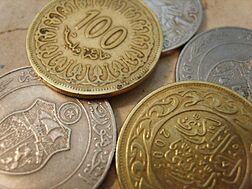Tunisian dinar facts for kids
Quick facts for kids Tunisian dinar |
|||
|---|---|---|---|
|
|||
| ISO 4217 Code | TND | ||
| User(s) | |||
| Inflation | 4.9% (Nov. 2020) | ||
| Subunit | |||
| 1⁄1000 | milim or millime | ||
| Symbol | د.ت | ||
| Coins | |||
| Freq. used | 50, 100, 200 millimes 1⁄2, 1, 2, 5 dinars |
||
| Rarely used | 1 ,2, 5, 10, 20 millimes | ||
| Banknotes | |||
| Freq. used | 5, 10, 20, 50 dinars | ||
The dinar is the official money of Tunisia. Its special code is TND. It is divided into 1000 smaller parts called milim or millimes.
People in Tunisia often use the short form DT. You might also see "dinar" written after the amount. The abbreviation TD is sometimes used, but it's less common. This is because French is often spoken in Tunisia, and DT comes from the French words for "Tunisian dinar."
Contents
Where the Name "Dinar" Comes From
The name "dinar" comes from an old Roman coin. This coin was called the denarius. It was used in the Roman province of Africa. This area is now modern-day Tunisia.
A Look at the Dinar's History
The dinar was officially started in 1960. It had been used as a way to count money since 1958. Before the dinar, Tunisia used the Tunisian franc. One dinar was worth 1000 francs.
The dinar did not follow the French franc when its value changed in 1958. Instead, the dinar was linked to the United States dollar. One dinar was equal to 2.38 dollars. This link lasted until 1964. Then, the dinar's value changed to 1 dinar for 1.90 dollars. This rate stayed the same until the dollar's value changed in 1971.
Tunisia used to have very low inflation. Inflation means prices go up over time. Between 2000 and 2010, the dinar was more stable. This was compared to money in nearby countries. However, the dinar's value has gone down since then. From 2008 to 2018, it lost about 55% of its value against the US dollar. It also lost about 46% against the euro.
Coins of Tunisia
In 1960, Tunisia started using new coins. These included 1, 2, and 5 millime coins made of aluminum. There were also 10, 20, 50, and 100 millime coins made of brass. The 1 and 2 millime coins are no longer used.
In 1968, 1⁄2 dinar coins were made from nickel. Later, in 1976, smaller coins were introduced. At that time, 1 dinar coins were also made. In 2002, special 5 dinar coins were introduced. These coins were made from two different metals.
Here are some of the coins you can find in Tunisia:
- 1 millime
- 5 millimes
- 10 millimes
- 20 millimes
- 50 millimes
- 100 millimes
- 200 millimes
- 1⁄2 dinar (which is 500 millimes)
- 1 dinar (which is 1000 millimes)
- 2 dinars (which is 2000 millimes)
- 5 dinars (which is 5000 millimes)
On December 26, 2013, two new coins were released. These were the 200 millimes coin and the 2 dinar coin. They have a special 13-sided shape.
Banknotes of Tunisia
The Central Bank of Tunisia first released banknotes on November 3, 1958. These were in values of 1⁄2, 1, and 5 dinars. New designs for these notes came out in 1966. A 10-dinar note was added in 1970.
The last 1⁄2-dinar notes were from 1973. The last 1-dinar notes were from 1980. In 1984, 20-dinar notes were introduced. Between 1997 and 2011, 30-dinar notes were used. In 2009, 50-dinar notes were released. An updated 10-dinar note came out in 2005.
By the end of 2019, all banknotes made before 2011 were no longer valid. You could exchange them at the Central Bank until that date.
After the government change in Tunisia, new banknotes were slowly released. A new 20-dinar note came out in 2017. A new 10-dinar note was released in 2020. As of 2020, 20 and 50 dinar notes from 2011 are still used. Also, 5 and 10 dinar notes from 2013 are in use. In 2022, new 5 and 50 dinar banknotes were introduced.
| Old Banknotes (No Longer Used) | |||||
|---|---|---|---|---|---|
| Image | Value | Main color | Description | ||
| Obverse | Reverse | Obverse | Reverse | ||
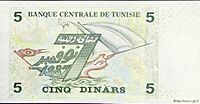 |
5 dinars | Green | Hannibal, Port Punique (Carthage) | Design celebrating a government change in 1987 | |
 |
 |
5 dinars | Lime Green | City of Carthage; Carthaginian general, Hannibal wearing a helmet | Carthaginian ships |
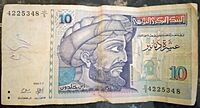 |
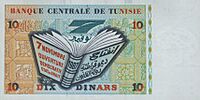 |
10 dinars | Blue | Ibn Khaldoun | Design celebrating a government change in 1987 |
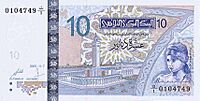 |
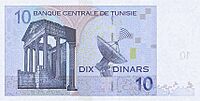 |
10 dinars | Blue | Elissa (Dido) | Sbeitla temple, satellite dish |
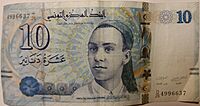 |
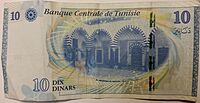 |
10 dinars | Blue and Yellow | Aboul-Qacem Echebbi | Arches of Medesa Bacchia school in Tunis |
 |
 |
20 dinars | Purple | Kheireddine Et-Tounsi | Design celebrating a government change in 1987 |
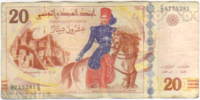 |
 |
20 dinars | Red, blue, and yellow | Kheireddine Et-Tounsi, Ksar Ouled Soltane fortified granary | L’École Sadiki (Sadiki College) building in Tunis |
 |
 |
30 dinars | Green, orange | Aboul-Qacem Echebbi | Tunisian farm with goats |
 |
50 dinars | Green and purple | Ibn Rachik, the City of Culture building | Rades bridge, Enfidha-Hammamet International Airport | |
 |
 |
50 dinars | Green, blue, and orange | Ibn Rachik, Musée de la Monnaie (Currency Museum) building | Place Gouvernement la Kasbah, central square in Tunis |
| Current Banknotes | |||||
|---|---|---|---|---|---|
| Image | Value | Main Color | Description | ||
| Obverse | Reverse | Obverse | Reverse | ||
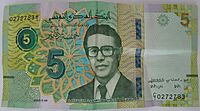 |
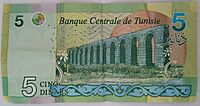 |
5 dinars | Green | Slaheddine el Amami | Roman aqueducts in Zaghouan |
 |
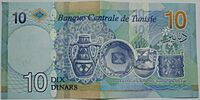 |
10 dinars | Blue | Tewhida Ben Sheikh | Berber pottery and jewelry |
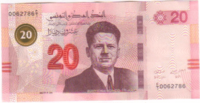 |
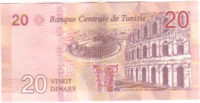 |
20 dinars | Red | Farhat Hached | Amphitheater of El Djem |
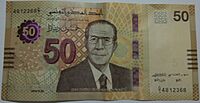 |
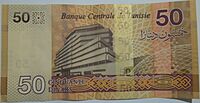 |
50 dinars | Brown | Hedi Nouira | Building of the Central Bank of Tunisia |
How Tunisians Talk About Money
Sometimes, Tunisians use different ways to say prices. For example, one dinar and a half (1.5 dinars) is often called "fifteen hundred." This is like saying "fifteen hundred millimes." This way of speaking is used for prices under 2 dinars.
For larger amounts, 50 dinars might be called "fifty thousand." This means "fifty thousand millimes." This can even apply to very high prices. For instance, 70,000 dinars could be called "seventy million." This means "seventy million millimes."
Also, people sometimes say "francs" instead of "millimes." So, 100 millimes (0.1 dinars) might be called "100 francs." The word "franc" comes from when France ruled Tunisia.
Rules for Tunisian Money
It is against the law to bring dinars into or out of Tunisia. This is because it is a "closed currency." This means its value is mainly for use within the country.
Each year, Tunisian citizens can change up to 6,000 Tunisian dinars into other money. This is allowed before they leave the country. Because of this rule, shops at the airport that don't charge taxes (duty-free shops) use other currencies. They accept euros, US dollars, and British pounds. Tourists can find many ATMs in Tunisia to change their money.
| Current TND exchange rates | |
|---|---|
| From Google Finance: | AUD CAD CHF EUR GBP HKD JPY USD |
| From Yahoo! Finance: | AUD CAD CHF EUR GBP HKD JPY USD |
| From XE.com: | AUD CAD CHF EUR GBP HKD JPY USD |
| From OANDA: | AUD CAD CHF EUR GBP HKD JPY USD |
| From fxtop.com: | AUD CAD CHF EUR GBP HKD JPY USD |
See also
- Economy of Tunisia
- Carthaginian shekel
- Denarius
- Tunisian rial or piastre
- Tunisian franc
- Algerian dinar
- Libyan dinar


